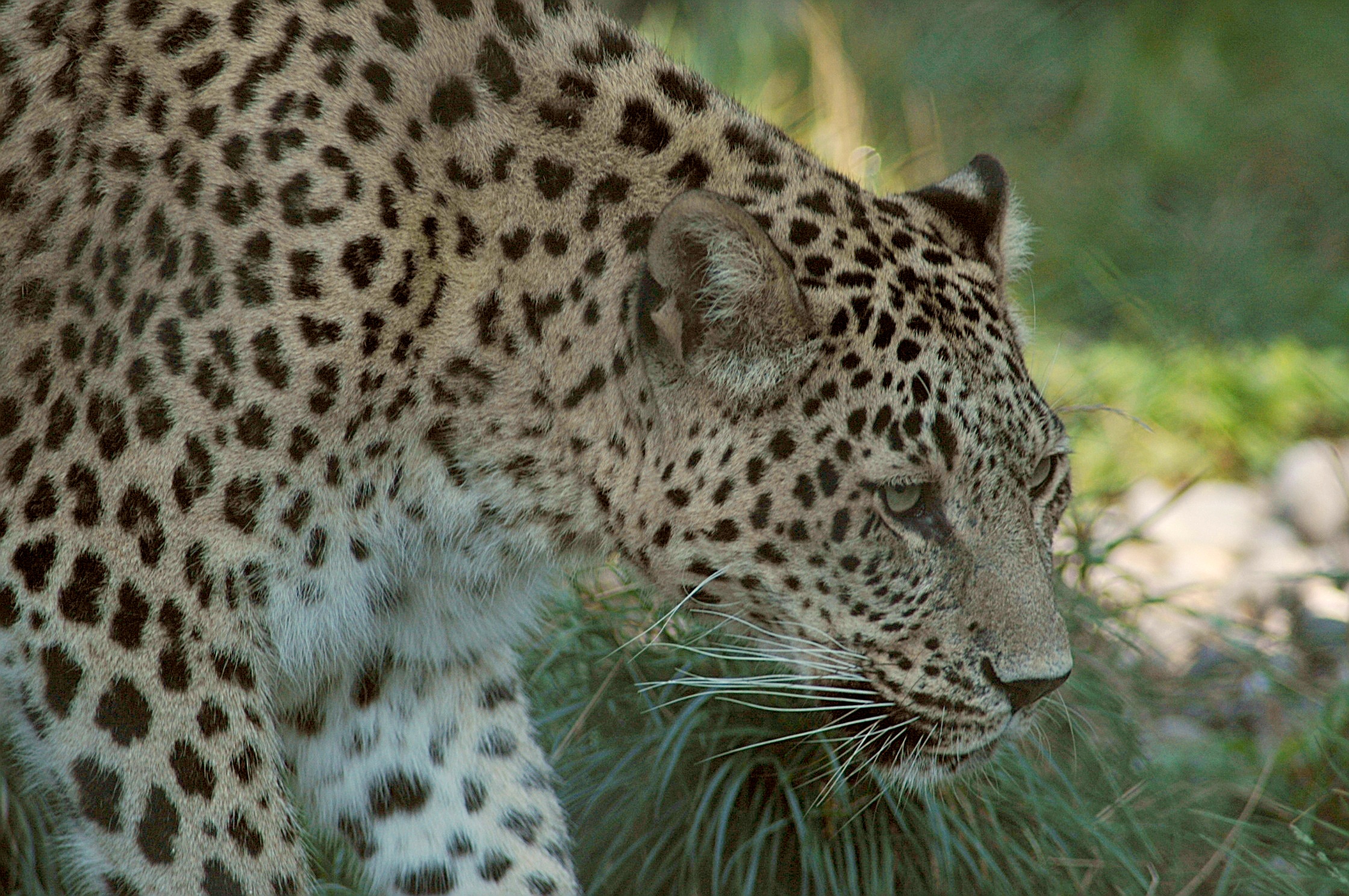- Persian Leopard
Taxobox
name = Persian leopard

image_width = 250px
status = EN
status_system=iucn3.1
trend = down
regnum =Animal ia
phylum = Chordata
classis =Mammal ia
ordo =Carnivora
familia =Felidae
genus = "Panthera "
species = "P. pardus"
subspecies = "P. p. saxicolor"
trinomial = "Panthera pardus saxicolor"
trinomial_authority = Pocock, 1927The Persian leopard ("Panthera pardus saxicolor"), or Iranian leopard, is one of the
leopard subspecies native to westernAsia . It is endangered throughout its range in theMiddle East .Description
The Persian leopard is said to be the largest of all the subspecies of leopards in the world. It can grow to up to 1.5 to 2.7 feet tall at the shoulder, and weigh as much as 155 lbs. Before 1990, when
Armenia ,Azerbaijan , Georgia,Russia , andTurkmenistan were the Soviet republics, the scientific names of the leopard used in these countries were P.p. tulliana and P.p. ciscaucasica, whereas the name P.p. saxicolor had been traditionally used by the western specialists for the cats inIran and, partially,Afghanistan . There are currently a few hundred left in the world.Range and Habitat
It is found in
Iran ,Azerbaijan ,Armenia ,Turkmenistan ,Uzbekistan ,Tajikistan , and northwesternAfghanistan . Habitat varies from mountain steppe to grasslands, or anywhere having a reasonable amount of cover and a supply of prey. Unconfirmed reports of big cats in the far southeast ofTurkey might also pertain to these animals; see the Caspian Tiger article for details.Persian Leopard in Armenia
In
Armenia , the Persian leopards live in the juniper sparse forests and, to a lesser extent, in arid and mountain grasslands, subalpine and alpine meadows. Their haunts are extremely rough and rocky places with plenty of cliffs. This predator uses the same trails during regular movements, so knowing where they are, the researcher can find the evidence of leopard existence such as scats, tracks and scrapes. The leopard inArmenia is threatened by disturbance, poaching, and wild fire, but which of these factors are most stressful for this cat is still unclear. The leopard can also be found in theShikahogh State Preserve .Persian Leopard in Azerbaijan
The Persian leopard lives in the southern regions in
Azerbaijan , primarily in theTalysh Mountains ,Nagorno-Karabakh andNakhichevan . Despite occasional sightings, it was not clear whether leopards had been extinct in Azerbaijan by the late 1990s until a species was caught on camera in March2007 in theHirkan National Preserve .Persian Leopard in Georgia
There are very few leopards left in the wild in Georgia. At present, they primarily live in dense forests, although several have been spotted in the lowland plains in the southeastern region of
Kakheti in 2004 [Antelava, Natalia. Lone leopard spotted in Georgia. BBC News. 2004. 1 July, 2007. http://news.bbc.co.uk/2/hi/science/nature/3746491.stm ] . Over the last 60 years, there have been several sightings of the leopard around theTbilisi area and in theShida Kartli province to the northwest of the capital.Persian Leopard in Iran
The habitat of the Persian Leopard is mainly found in the
Alborz and theZagros mountain ranges. These ranges cover a vast area starting from the borders with Turkey, Azerbaijan and Armenia, extending to the Caspian litoral region and on to Turkmenistan and western parts of Afghanistan in theAlborz range. Along theZagros range, leopard habitats extend to the south of Iran, close to thePersian Gulf . The habitat of the Persian Leopard may cover a wide area of Iran, but leopard populations are scattered, fragmented and threatened. Human settlements and activities are the main threats for the species. The Persian Leopard's main prey in Iran is Bezoar goat (Capra aegagrus ) and wild sheep (Ovis ammon spp ). On occasion, leopards may prey on Boar (Sus scrofa ), Red Deer (Cervus elaphus maral ) and domestic animals such as camels, goats, sheep or dogs.The principle threats to Persian Leopard survival in Iran are population fragmentation and loss of habitat due to human population encroachment, poisoning and poaching.The Persian Leopard is a flag-ship species and its presence is a sign of the health of the entire ecosystem. The Persian Leopard is an apex predator in most of Iran's provinces. The leopard's chances for survival outside the protected areas of the Department of the Environment appear very slim.Diet
A leopard's diet varies depending on where it thrives. The Persian leopard's diet varies from small mammals and birds, to larger animals such as,
deer ,antelope , Bezoar ibex, and occasionallywild boar .Threats
This species is listed as endangered and commercial trade of this species is prohibited by international law. The Persian leopard has been threatened due to persecution, habitat loss, and poaching. It is also one of the animals in western Asia which is suffering from warfare in its mountain range.
References
Bibliography
* Khorozyan, I. et al. 2005. The Persian Leopard Prowls Its Way to Survival. Endangered Species Update 22 (2): 51-60
* Ministry of Nature Protection,Yerevan ,Armenia
* Center of Ecological studies,Yerevan ,Armenia
* M. Jahanshai. 2002. Population status of the Persian Leopard inIran .
* Woodroffe, R. 2000. Predators and people 165-173.
* Zulfiqar, A. 2001. Leopard in Pakistan’s North West Frontier Province. Cat News 35: 9-10.
* Shakula, V. 2004. First record of leopard inKazakhstan . Cat News 41: 11-12.
* Gasparyan, K.M. and F.S. Agadjanyan. 1974. The panther in Armenia. Biological Journal of Armenia 27: 84-87.
* Janashvili, A. "Leopard." Georgian Soviet Encyclopedia. Vol. 11, Tbilisi, 1984, pp. 567
* Ali Aghili. 2004. Persian Leopard in the Caucasus Range of Iran
* Ali Aghili. 2004. Persian Leopard in North-East of IranExternal links
* [http://persianleopardcs.org Persian Leopard Conservation Society]
* [http://carnivoreconservation.portland.co.uk/items/persianleopard.html The Persian leopards in Armenia]
* [http://www.lpzoo.com/animals/FACTS/mammals/afg_leopard.html Persian leopard fact sheet]
* [http://www.msnbc.msn.com/id/20267987/ Zoo reveals rare Persian leopard triplets]
Wikimedia Foundation. 2010.
